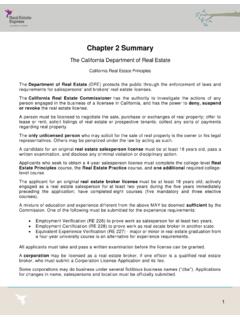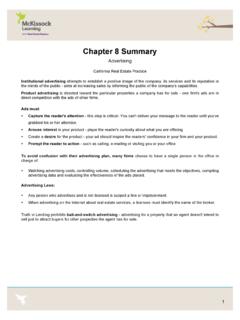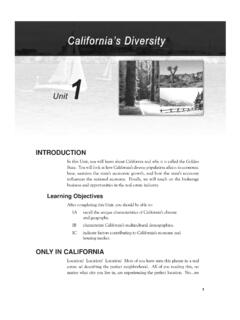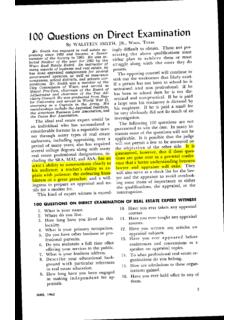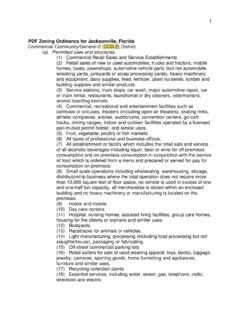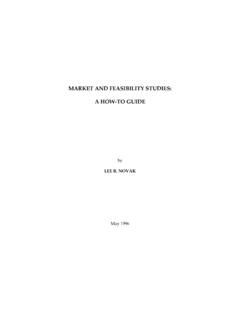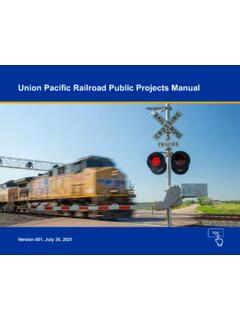Transcription of Legal Descriptions - McKissock Learning
1 Chapter 9: Legal Descriptions 119 9 Legal Descriptions Methods of Legal Description Metes and Bounds The Rectangular Survey System Recorded Plat Method Describing Elevation METHODS OF Legal DESCRIPTION There are many common ways of describing properties: address (100 Main Street), name (Buckingham Palace), and general description ("the south forty acres"). Such informal Descriptions are not acceptable for use in public recordation or, generally speaking, in a court of law because they lack both permanence and sufficient information for a surveyor to locate the property.
2 Even if a Legal document or public record refers to an address, the reference is always supported by an accepted Legal description. A Legal description of real property is one which accurately locates and identifies the boundaries of the subject parcel to a degree acceptable by courts of law in the state where the property is located. The general criterion for a Legal description is that it alone provides sufficient data for a surveyor to locate the parcel. A Legal description identifies the property as unique and distinct from all other properties.
3 Legal description provides accuracy and consistency over time. Systems of Legal description, in theory, facilitate transfers of ownership and prevent boundary disputes and problems with chain of title. A Legal description is required for: public recording creating a valid deed of conveyance or lease completing mortgage documents executing and recording other Legal documents In addition, a Legal description provides a basis for court rulings on encroachments and easements. 120 Principles of real estate Practice The three accepted methods of legally describing parcels of real estate are: metes and bounds rectangular survey system, or government survey method recorded plat method, or lot and block method Since the metes and bounds method preceded the inception of the rectangular survey system, the older East Coast states generally employ metes and bounds Descriptions .
4 States in the Midwest and West predominantly use the rectangular survey system. Some states combine methods. METES AND BOUNDS A metes and bounds description identifies the boundaries of a parcel of real estate using reference points, distances, and angles. The description always identifies an enclosed area by starting at an origination point, called point of beginning, or POB, and returning to the POB at the end of the description. A metes and bounds description must return to the POB in order to be valid. The term "metes" refers to distance and direction, and the term "bounds" refers to fixed reference points, or monuments and landmarks, which may be natural and artificial.
5 Natural landmarks include trees, rocks, rivers, and lakes. Artificial landmarks are typically surveyor stakes. Many states use metes and bounds description to describe properties within the rectangular survey system. A metes and bounds description begins with an identification of the city, county, and state where the property is located. Next, it identifies the POB and describes the distance and direction from the POB to the first monument, and then to subsequent monuments that define the property's enclosed perimeter. Chapter 9: Legal Descriptions 121 Exhibit Metes and Bounds Description A parcel of land located in Bucks County, Pennsylvania, having the following description.
6 Commencing at the intersection of the south line of Route 199 and the middle of Flint Creek, thence southeasterly along the center thread of Flint Creek 410 feet, more or less, to the willow tree landmark, thence north 65 degrees west 500 feet, more or less to the east line of Dowell Road, thence north 2 degrees east 200 feet, more or less, along the east line of Dowell Road to the south line of Route 199, thence north 90 degrees east 325 feet, more or less, along the south line of Route 199 to the point of beginning. 122 Principles of real estate Practice THE RECTANGULAR SURVEY SYSTEM The survey grid Sections of township Fractions of a section Converting section fractions to acres The federal government developed the rectangular survey system, or government survey method, to simplify and standardize property Descriptions as a replacement for the cumbersome and often inaccurate metes and bounds method.
7 The system was further modified to facilitate the transfer of large quantities of government-owned western lands to private parties. To institute the system, all affected land was surveyed using latitude (east-west) and longitude (north-south) lines. The object was to create uniform grids of squares, called townships, which would have equal size and be given a numerical reference for identification. The rectangular survey system works well for describing properties that are square or rectangular in shape, since these can be described as fractions of sections.
8 However, for an irregular shape, such as a triangle, the rectangular system is inadequate as a method of Legal description. The full description has to include a metes and bounds or lot and block description. The survey grid The following exhibit shows a portion of the rectangular survey system. Exhibit A Sample Survey Grid: Florida Meridian. The north-south, longitudinal lines on the survey grid are meridians. The principal meridian is the single designated meridian for identifying townships in the principal meridian's geographical "jurisdiction.
9 " There are 37 principal meridians in the national survey. In the exhibit, the principal meridian is the Tallahassee Principal Meridian. Chapter 9: Legal Descriptions 123 Parallel. The east-west, latitudinal lines are called parallels. The base parallel or base line is the designated line for identifying townships. There is a base parallel for each principal meridian Range. The north-south area between consecutive meridians is called a range. The area labeled "B" in the exhibit is a range. A range is identified by its relationship to the principal meridian.
10 All ranges are six miles wide. Tier. The east-west area between two parallels is called a tier, or a township strip. The area marked "C" in the exhibit is a tier. A tier is identified by its relationship to the base parallel. All tiers are six miles wide. Township. A township is the area enclosed by the intersection of two consecutive meridians and two consecutive parallels, as the shaded square marked "A" in the exhibit illustrates. Since the parallels and meridians are six miles apart, a township is a square with six miles on each side.
